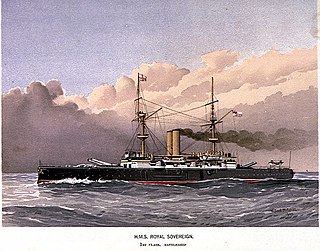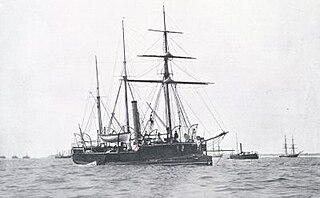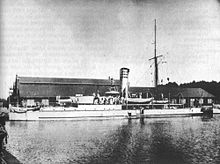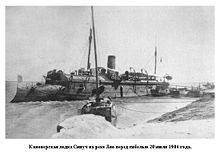
Protected cruisers, a type of cruising warship of the late-19th century, gained their description because an armoured deck offered protection for vital machine-spaces from fragments caused by shells exploding above them. Protected cruisers resembled armored cruisers, which had in addition a belt of armour along the sides.

A monitor is a relatively small warship that is neither fast nor strongly armored but carries disproportionately large guns. They were used by some navies from the 1860s, during the First World War and with limited use in the Second World War.

An ironclad is a steam-propelled warship protected by steel or iron armor constructed from 1859 to the early 1890s. The ironclad was developed as a result of the vulnerability of wooden warships to explosive or incendiary shells. The first ironclad battleship, Gloire, was launched by the French Navy in November 1859, narrowly preempting the British Royal Navy. However, Britain built the first completely iron-hulled warships.

A warship or combatant ship is a ship that is built and primarily intended for naval warfare. Usually they belong to the armed forces of a nation. As well as being armed, warships are designed to withstand damage and are typically faster and more maneuverable than merchant ships. Unlike a merchant ship, which carries cargo, a warship typically carries only weapons, ammunition and supplies for its crew. Warships usually belong to a navy, though they have also been operated by individuals, cooperatives and corporations.

A gunboat is a naval watercraft designed for the express purpose of carrying one or more guns to bombard coastal targets, as opposed to those military craft designed for naval warfare, or for ferrying troops or supplies.

HMQS Gayundah was a flat-iron gunboat operated by the Queensland Maritime Defence Force and later the Royal Australian Navy. She entered service in 1884 and was decommissioned and sold to a civilian company in 1921. She then served as sand and gravel barge in Brisbane until the 1950s, when she was scrapped. In 1958, Gayundah was run aground at Woody Point near Redcliffe, to serve as a breakwater structure.

Pre-dreadnought battleships were sea-going battleships built from the mid- to late- 1880s to the early 1900s. Their designs were conceived before the appearance of HMS Dreadnought in 1906 and their classification as "pre-dreadnought" is retrospectively applied. In their day, they were simply known as "battleships" or else more rank-specific terms such as "first-class battleship" and so forth. The pre-dreadnought battleships were the pre-eminent warships of their time and replaced the ironclad battleships of the 1870s and 1880s.

George Wightwick Rendel was an English engineer, and naval architect. He was closely associated with the Tyneside industrialist and armaments manufacturer, William George Armstrong.

HMQS Paluma was a flat-iron gunboat operated by the Queensland Maritime Defence Force and later the Royal Australian Navy. She entered service on 28 October 1884, was decommissioned in 1916 and then sold to the Victorian Ports and Harbours Department, who operated her under the name Rip until 1948 when she was retired. She was scrapped in 1950–51.

The Battle of Kinburn, a combined land-naval engagement during the final stage of the Crimean War, took place on the tip of the Kinburn Peninsula on 17 October 1855. During the battle a combined fleet of vessels from the French Navy and the British Royal Navy bombarded Russian coastal fortifications after an Anglo-French ground force had besieged them. Three French ironclad batteries carried out the main attack, which saw the main Russian fortress destroyed in an action that lasted about three hours.

A floating battery is a kind of armed watercraft, often improvised or experimental, which carries heavy armament but has few other qualities as a warship.

The Sachsen class of armored corvettes was a class of four ships built by the Imperial German Navy in the late 1870s to early 1880s. The ships—Sachsen, Bayern, Württemberg, and Baden—were designed to operate as part of an integrated coastal defense network. The ships were intended to sortie from fortified bases to break up an enemy blockade or landing attempt. Armed with six 26 cm (10.2 in) guns, they were also intended to fight hostile ironclads on relatively equal terms.

HMCSProtector was a large flat-iron gunboat commissioned and purchased by the South Australian government in 1884, for the purpose of defending the local coastline against possible attacks in the aftermath of the 'Russian scare', of the 1870s. She arrived in Adelaide in September 1884 and served in the Boxer Rebellion, World War I and World War II.

The Italian Castore-class gunboats, Castore and Polluce, were a class of two Rendel gunboats, designed and built by Sir W G Armstrong Mitchell & Co.'s Elswick Works in the late 1880s to a contract by the Italian War Ministry. Designed by Philip Watts and Herbert Rowell, and constructed in Elswick's Tyneside yard in the United Kingdom, the two gunboats were disassembled and shipped to Italy for reassembly in the Armstrong facility at Pozzuoli, proving to be the only ships constructed there after the Italian government cancelled the shipyard project. It is uncertain whether the vessels were designed as testbeds for heavy guns, or were intended from the outset as operational gunboats.

The Ant-class gunboat was a class of twenty-four Royal Navy flat-iron gunboats mounting a single 10-inch gun, built between 1870 and 1880. They carried no masts or sails, being among the first Royal Navy vessels not to do so. The last four vessels were ordered separately and are sometimes known as the Gadfly class, although they were essentially identical. Members of the class lingered on as steam lighters, dredgers, boom defence vessels and base ships, lasting in some cases into the 1950s.

By taking on ships being built for foreign navies in British shipyards, a number of British-built 6-inch 50-calibre naval guns found their way into British service in World War I. Their specifications and performance differed from standard Royal Navy 6-inch guns but in British service they fired standard service 100-pound projectiles.

HMS Trent was a Medina-class gunboat launched in 1877. She was the fifth ship of the Royal Navy to be named after the River Trent. She was renamed HMS Pembroke in 1905, and served off the coast of Tanganyika in 1915. She was renamed HMS Gannet in 1917 while serving as a diving tender. She was scrapped in 1923.

The Medina-class gunboat was a class of 12 Royal Navy Rendel gunboats mounting three 6.3-inch guns, built between 1876 and 1877. Flat-iron gunboats were normally built without masts or rigging, but the Medinas carried a full barquentine rig. Their robust iron hulls meant that they lingered on as diving tenders, barges and lighters, with five of them working into the 1920s. The hull of Medway lies in shallow water in Bermuda and is visible on satellite imagery.

Piemonte was a unique protected cruiser built for the Italian Regia Marina in the 1880s by the British shipyard Armstrong Whitworth. She was the first major warship armed entirely with quick-firing (QF) guns and she was also the fastest cruiser in the world upon her completion in 1889. Piemonte was frequently deployed overseas, including a lengthy tour in East Asian waters from 1901 to 1904. She saw significant action during the Italo-Turkish War in 1911–1912 in the Red Sea, where she frequently bombarded Ottoman ports. During the Battle of Kunfuda Bay in January 1912, she and two destroyers sank four Ottoman gunboats and forced ashore three more. Piemonte participated in World War I but she saw little action during the conflict. She remained in service until 1920, when she was scrapped.




























